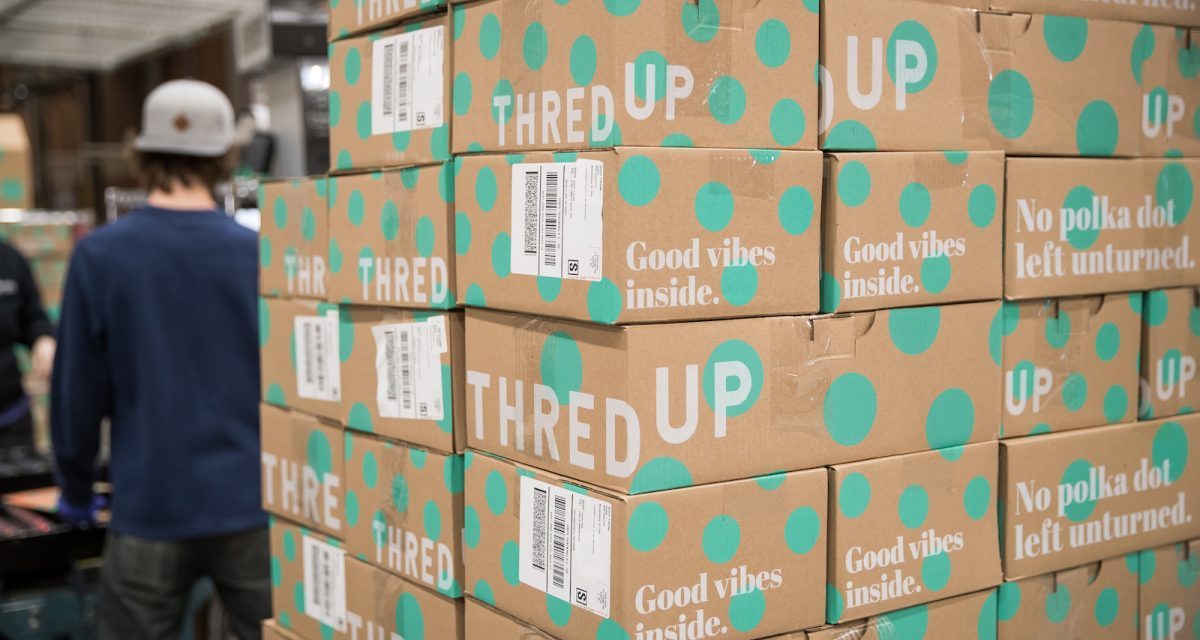In effort to scale, ThredUp pitches services business to retailers

ThredUp is expanding, and sees legacy retailers as its ticket to scale. The company is now launching a platform that it will sell to larger retailers looking to gin up new business.
A week after announcing new partnerships with JCPenney, Macy’s, and Stage stores the clothing resale company announced Wednesday a new investment round of $175 million, led by Park West Asset Management and Irving Investors. As part of this cash infusion, the company declared itself no longer just a online way to buy and sell clothing.
The new service is a bundling of what it’s built for itself but offered to others. Retailers can pay to build ThredUp experiences in-store — which would feature ThredUp’s own inventory, as well a way for customers to drop of their own used clothes, which would be sent to ThredUp’s warehouses. The platform lets businesses who don’t want to build out their own consignment program feed into ThredUp’s infrastructure.
While the offerings aren’t necessarily new, this repositioning shows ThredUp trying to get ahead of the competition. Currently, online resale is heating up — ThredUp’s own research said the overall market was worth $24 billion 2018. A number of players are currently in a mad dash to become the most ubiquitous — including the Real Real, StockX, Stich Fix and Poshmark. While their models are all slightly different, each one is betting that more consumers will seek out used goods online in the future. For ThredUp, this new platform is a way for it to partner with retailers so that it can get its name in front of even more shoppers.
The company is essentially trying to establish itself as a leader in the ever-crowding resale space; it’s a marketing pivot of the services it already offers. The consignment business is anything but easy. Resale requires a bunch of onerous and difficult to scale tasks — namely, taking in inventory (and a lot of it), sorting through it, figuring out what’s good and what’s not, uploading the winners online, marketing them accordingly and then shipping the goods back out to the buyer.
It takes loads of technology, physical storage and logistic know-how to create an efficient workflow to digitize the thrifting experience. Much of this investment, explained ThredUp co-founder and CEO James Reinhart, was on building out its back-end services; “We have to continue to invest in our infrastructure,” he said.
A new pitch
But infrastructure isn’t ThredUp’s main focus anymore. It’s now trying to pitch itself as a B2B service provider. Most resale platform’s strategies have been focused squarely on customer acquisition. ThredUp, along with competitors like Stitch Fix, Poshmark and RealReal have been in a years-long mad dash to make online used shopping more of a thing. ThredUp’s new plan to grow is to find the customers where they already are — namely, at a retail store.
ThredUp is presenting this as a services expansion and technological upgrade. But it seems like this move is a way to market it as amenable to more large-scale retail partnerships. For example, the Macy’s and JCPenney’s program — which set up displays in select stores that feature curated ThredUp apparel — aren’t changes to how either store operates; they’re simply a new brick-and-mortar storefront that will give ThredUp many smaller physical locations; they are stores within stores. (Reinhart wouldn’t share whether the partnerships worked by charging rent or providing a cut of the sale.)
Similarly, another partnership with the women’s apparel company Cuyana simply included ThredUp shipping labels in every Cuyana online order — essentially nudging these customers to also give up some clothes they don’t wear. These platform integrations are ways for larger businesses to easily include the features ThredUp already offered.
While that’s not necessarily a technological innovation, it could be helpful to both companies involved. For retailers like Macy’s and JCPenney, it’s a way for the ailing department stores to enter the resale industry without having to invest their own resources into the process. For ThredUp, it’s a way to establish physical presences and grow its domain.
According to Reinhart, this is an easy way for big companies to establish to customer that they are at least interested in offering second-hand clothing. It also allows the retailers to integrate their own new products with the used ones to create, as he described, a “hybrid experience.” The CEO added that the pilots in the three retailers currently represent about 100 stores, and he hopes to ThredUp’s physical presence expands to the other locations.
In essence, this newly-announced platform launch is just a way for ThredUp to bill itself as amenable to more partnerships with bigger companies. The company has built out its infrastructure to accept people’s previously-worn for the last decade, and now wants more people to know it’s possible.
To Reinhart, this is the next step in making the process of buying used clothes online more ubiquitous. The company began by offering a website, and now it wants more people to know it eats. “Everyone expects these disruptions to happen overnight,” he said. “Resale is still in the early innings.”
